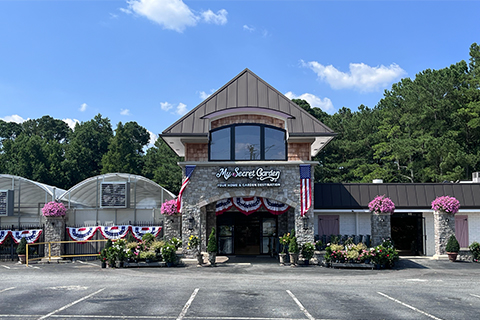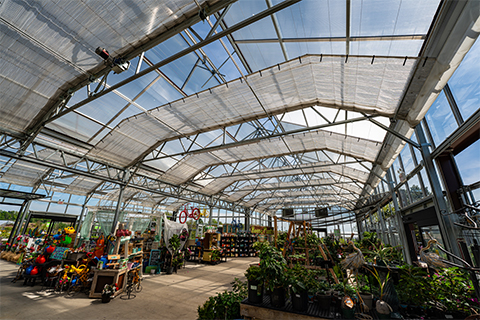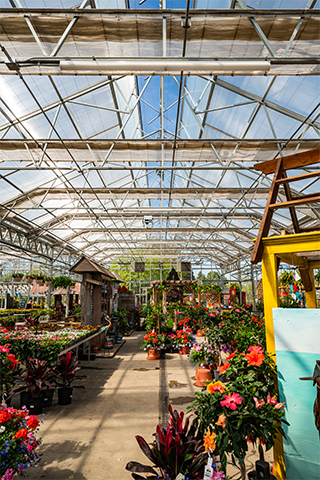7/31/2025
Retail Revamp
Jennifer Polanz
Whether it’s fair or not, consumers are judging your store before they even set foot inside it. They look from the outside and start making decisions on what the value of the product inside is based on how it looks outside. That’s why it’s vital to make a good first impression and to set the tone of the visit straight away. Making improvements to your facilities can also create more excitement, renewed interest, greater operational efficiencies and a more pleasant experience for guests and team members. I talked to three retailers about how they improved their facilities, all with great success.
Dothan Nurseries: A Glow Up
 JD Boone’s parents started Dothan Nurseries in 1988 and built an Atlas Greenhouse as the main showroom building. Being in Dothan, Alabama, shade cloth does a lot of the heavy lifting, but there’s still need for indoor shopping, especially for houseplants. The bones were still good, but the greenhouse sidewalls were yellowing and the gutters were leaking. They’d replaced the plastic a couple of times themselves, but after getting some help from Atlas Regional Sales Manager Chuck Sierke, JD decided to bring in the Atlas team for help.
JD Boone’s parents started Dothan Nurseries in 1988 and built an Atlas Greenhouse as the main showroom building. Being in Dothan, Alabama, shade cloth does a lot of the heavy lifting, but there’s still need for indoor shopping, especially for houseplants. The bones were still good, but the greenhouse sidewalls were yellowing and the gutters were leaking. They’d replaced the plastic a couple of times themselves, but after getting some help from Atlas Regional Sales Manager Chuck Sierke, JD decided to bring in the Atlas team for help.
They added a new door to improve the flow from the greenhouse to the outside sales yard.
The Atlas crew replaced the walls with clear polycarbonate sheets, replaced the poly on the roof, fixed the leaks, changed up where the fans were placed for better airflow, added a new door out to the perennials, and a few other odds and ends. The result was a much nicer, visually appealing shopping experience that improved traffic flow and improved the quality of the product by moving the fans (they were drying out the perennials where they were placed before).
 “It helped me feel more comfortable raising prices,” JD said of the renovated greenhouse. “Not just because the cost is going up, but just because of the perceived value of what we have going on here made the plants look more valuable.”
“It helped me feel more comfortable raising prices,” JD said of the renovated greenhouse. “Not just because the cost is going up, but just because of the perceived value of what we have going on here made the plants look more valuable.”
Here you can see the new clearer sidewalls on the greenhouse at Dothan Nurseries in Dothan, Alabama.
Chuck agreed, noting they’ve seen the results in other cases, too.
“Renovating has a direct correlation to increased profit,” he added. “Make your garden center a profit center by renovating, doing additions and proving a fresh new look.”
The result this spring was a 20% increase in houseplant sales, which JD only really noticed after spring had finished. They were busy marketing roses, annuals and other typical spring product, and yet the houseplant sales increased without any marketing help. The improvements also help with events like their Sip and Shop events, which they do once a month featuring wine, food, twinkly lights and houseplant sales. “Those have done well for us, too, which I think work well with the nice new look of the greenhouse.”
One thing he wanted others to know is that the greenhouse companies can help if you reach out to them.
The houseplant department gets a little wild!
 “They made it really easy. I’m pretty good at this retail garden centering, but I just get intimidated by things. I thought about doing the greenhouse before, but I just wasn’t even aware that you could call somebody and they would send 10 people out for two weeks to work on your greenhouse,” he said, adding they just always tried to fix it themselves. “I think Chuck came by randomly. And I was like, ‘Man, do people just come out and fix greenhouses?’ He’s like, ‘Yeah, that’s what we do. What do you want to do?’”
“They made it really easy. I’m pretty good at this retail garden centering, but I just get intimidated by things. I thought about doing the greenhouse before, but I just wasn’t even aware that you could call somebody and they would send 10 people out for two weeks to work on your greenhouse,” he said, adding they just always tried to fix it themselves. “I think Chuck came by randomly. And I was like, ‘Man, do people just come out and fix greenhouses?’ He’s like, ‘Yeah, that’s what we do. What do you want to do?’”
JD has some ideas for the future that involve structures for bareroot rose growing and storage for pre-order plants. Stay tuned!

My Secret Garden: A New Location
Sonya Harrison isn’t averse to risk—she came in to liquidate a previous garden center’s inventory at her former 1-acre Peachtree Corners, Georgia, location and ended up staying to open a garden center and landscaping operation there. Last year, she bought a new, much larger garden center (more than 5 acres) in Snellville, relocating everything to the new facility. It’s a much bigger store with a busier main road.
The inviting entrance to My Secret Garden in Snellville, Georgia.
“There, I would have maybe 100, 200 cars. Here I have like 40,000, 50,000 every day come in front of my store. So I knew that I would get more traffic naturally coming in,” she said. “I was able to carry more things like fruit trees. I was able to order from vendors that I never ordered from before because I could accept bigger shipments.”
 That meant more variety this spring than she’s ever had before, like a wider selection of annuals, seeds and bulbs, and the aforementioned fruit trees and sod, all of which translated into greater sales. It’s taken some time to figure out her new clientele, but now she’s getting into the rhythm of what they want (although she still sees customers who drive from around her old location to shop her new store).
That meant more variety this spring than she’s ever had before, like a wider selection of annuals, seeds and bulbs, and the aforementioned fruit trees and sod, all of which translated into greater sales. It’s taken some time to figure out her new clientele, but now she’s getting into the rhythm of what they want (although she still sees customers who drive from around her old location to shop her new store).
The new additional lighting inside My Secret Garden.
She made several changes to the store to make it more her own, like changing the flagstone to look like granite, lots of additional lighting inside, new exhaust fans in the greenhouse and changed out a pallet-covered wall for clear polycarbonate, which allows customers to see from the houseplant section through to the greenhouse. She added an automatic door, too, leading customers into the greenhouse.
“People just love it,” she said. “I call it the ‘Wow Wall’ because when they come in, they’re like, ‘Wow.’”
She made improvements to the overhead irrigation system, which was in place, but in need of repair. The space allows for more options, too, like a classroom where she can hold seminars and workshops.
And, my favorite part of her additions, she has a secret garden (appropriate, right?). She created a meandering stone-lined path in the greenhouse filled with mulch, trees, shrubs, benches, fountains and even an artificial turf section for dogs.
 “In spring, we had a dedicated rose garden in our secret garden, which we’ve since taken out because they sold,” she added. “Everybody liked it, and it was really well displayed because you could see all the roses and it was pretty.”
“In spring, we had a dedicated rose garden in our secret garden, which we’ve since taken out because they sold,” she added. “Everybody liked it, and it was really well displayed because you could see all the roses and it was pretty.”
The entrance to the winding path of the secret garden.

Ebert’s Greenhouse Village: A New Build
For owner Mark Ebert, his new greenhouse started with a mailed pamphlet from Nexus that showed up on his desk. It was a beautiful Vail greenhouse with stone accents.
Inside the Nexus Vail greenhouse at Ebert’s Greenhouse Village in Ixonia, Wisconsin.
“I talked to Jesse (Siegenthaler, systems manager), talked to a few people here at Ebert’s and I said, ‘Well, this is going to be a huge investment, but what do you guys think ?’ And the few people that I asked, including Jesse, said that would totally transform Ebert’s and what we could do with it.”
At the time, they had a small store and three Quonset greenhouses up front. They’re a grower-retailer and they wanted the option to have a separate retail space. But they struggled with the idea of building something so big—they’re out in the country in Ixonia, Wisconsin (one of the prettiest garden retail spots I’ve ever seen), and he worried it would change the feel of the place. But they pulled the trigger and the 10,000-sq. ft. Vail was finished just in time for spring ... 2020. There was a hot minute when Mark panicked. But the customers came, and while they didn’t notice right away, oddly enough (call it a COVID fog), they did buy.

“I think we got more reaction after COVID started simmering down and people said, ‘Wow, was this here last year? This is gorgeous.’”
Ebert’s sold that greenhouse down to the sidewalls in 2020, which gave them the confidence to build another 6,600-sq. ft. greenhouse. Construction on that space started in 2021 and it opened for shoppers in spring 2022, housing more retail items and more registers. Customers love the covered shopping, Mark said. Along with that they laid concrete walkways in the tree and shrub areas, which increased traffic and shopping there.
“Promoting yourself is good, you know, but word of mouth is the best,” Jesse said. “And I’ve heard so many people make the comment that they tell people, ‘You’ve got to come out and see Ebert’s because of the improvements that have been done and the care that Mark takes in the grounds.’ It’s just presenting a very well-rounded shopping atmosphere.”
After building one, they opted for a second smaller greenhouse.
Mark said he was nervous about all the changes, but they’ve paid off, and he’d recommend the same to others who are looking to make changes, whether it’s small or large.
 “Our sales skyrocketed and our customer base went up. And I think it just stirred a lot more excitement,” Mark said. “So my recommendation to people thinking about it is I would do it, if they have the space or have the resources to do it.” GP
“Our sales skyrocketed and our customer base went up. And I think it just stirred a lot more excitement,” Mark said. “So my recommendation to people thinking about it is I would do it, if they have the space or have the resources to do it.” GP
From the outside of the 6,600 sq. ft. greenhouse built in 2021.